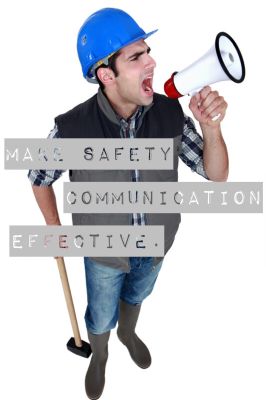There is a vast difference between communication and effective communication.
 Why is it that some supervisors and safety people can say something once and they get compliance? While other supervisors and safety people find they have to repeat themselves constantly. How can it be that one group gets it immediately and another needs constant reminding? There is a vast difference between communication and effective communication.
Why is it that some supervisors and safety people can say something once and they get compliance? While other supervisors and safety people find they have to repeat themselves constantly. How can it be that one group gets it immediately and another needs constant reminding? There is a vast difference between communication and effective communication.
Communication is only as good as the choice of words or the content of those words. The more precise and specific the choice of words and content, the more effective the communication. You have to communicate in a way that speaks directly to what you want said. Too many words and generic ideas only create misunderstandings and confusion. The better the choice of words, the clearer your ideas, the more your communication becomes effective.
So let’s take a look at three ways that you can improve your effectiveness in safety communication starting today:
1One idea at a time. Safety meetings are famous for doing this all wrong. Safety meetings can be a jumble of too many ideas, too many long presentations and too many people getting up to speak. On wordy Powerpoint slides, meeting attendees have to discern what’s important from what’s filler. The great thing is, there is no time limit on safety meetings. You are not required for meet a minimum amount of time filling and padding that time full of stuff. The more ideas you introduce into a meeting, the more you compete with your core message. The more speakers who speak on different things, the more it confuses the attendee. They can’t possibly remember all of it anyway. So tighten up. Focus on the “absolutely must-haves.” Meet more often if you have to. But do it for shorter periods of time. Plan your safety meetings like a 30-second timeout in sports. Focus on the plays (tasks) you are faced with today. Shorten up the meeting and get specific. No one ever complained that the safety meeting was too short so go for brevity and impact instead. Figure out what one or two things that you would like to see you people doing differently as a result of this meeting. Then, work backwards to plan and point all of your energy at accomplishing those one or two things.
2Make it personal. Dump the blanket reminders. In other words, don’t use generic terms and talk about “all of us” or “many employees” or “some people.” If you have a performance issue with one or two employees, don’t drag all of the other employees into it. Address the issues with the one or two. Don't punish everyone for the actions of a few. Don't waste their time by dragging them into admonishment sessions disguised as “gentle reminders.” Don’t make 30 people sit through a session that is supposed to fix one or two. Your communication isn’t personal then. And it’s certainly not relevant. And don’t think that everyone needs a gentle reminder now and then. No. No they don’t. They need a reminder that you are proud of what they are doing right, not what someone else is doing wrong. If you’ve got an employee who is doing it right, tell them they’re doing it right. Make your communication more effective. Engage your people at a personal level one-one-one; not as disguised reprimand sessions. People will improve when they get feedback directly focused on them. So engage each of your people at a personal level.
3Find a way to be positive. Yeah, this one’s more difficult. Especially when you know that an employee that you’re about to communicate with has been doing something wrong. It’s so much easier to find fault with and criticize someone’s performance. We know that to be a fact because so many of our own bosses find fault with us each day. No one ever likes to be dressed down or embarrassed for the work they do. No one shows up for work each day with a smile on their face knowing that someone is about to admonish them for their quality of work. People want to feel proud of the work they do. Everyone has a desire to be admired in some small way. So admire them. There has got to be something about each person on your crew who is worthy of some sort of compliment. If not, why are they still there? It takes no talent or skill to criticize. It takes great effort to find something positive about another’s performance. But it brings you and the employee so much closer. When your relationship gets closer, communication becomes more effective.
 Effective communication prevents having to needlessly repeat yourself. Effective communication also improves understanding and ultimately results. Stop just communicating and start effectively communicating.
Effective communication prevents having to needlessly repeat yourself. Effective communication also improves understanding and ultimately results. Stop just communicating and start effectively communicating.
Kevin Burns gives engaging, entertaining and inspiring speeches to front-line employees at safety meetings. He also works with supervisors and safety managers on-site or in keynote presentations at conferences. Kevin helps organizations integrate caring for and valuing employees through their safety programs. Kevin Burns is a management consultant, safety speaker and author of 9 books.He is based in Calgary, Canada.
©2016 ZeroSpeak Corporation and Kevin Burns.
No part of this post may be reproduced without the expressed consent of the author.


